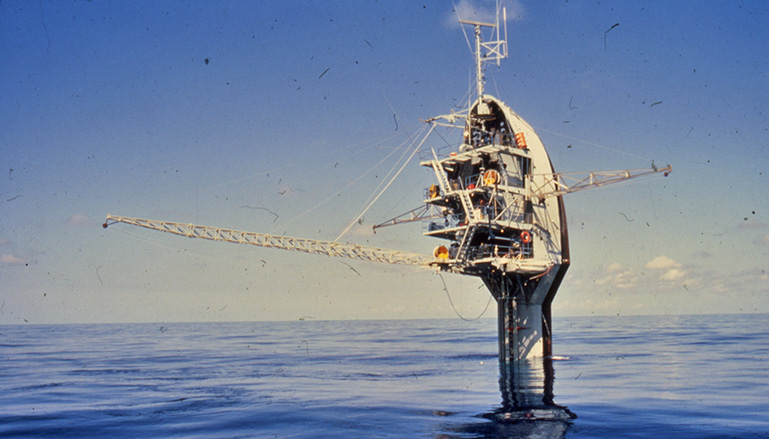“R/P FLIP: Spaceship at Sea,” by Rachel Mayeri
March 18, 2022
Professor of media studies, interdisciplinary artist, Rachel Mayeri here. I’m thrilled to share news about my participation in the Southern California-wide Pacific Standard Time exhibition on art and science, planned by the Getty Foundation for 2024. I’ve been tapped to produce a video installation for the Birch Aquarium in San Diego about a unique technological wonder in the history of oceanography.
The world-famous FLIP is a nautical marvel that flips 90 degrees to become a live-in buoy for marine study. Recently decommissioned, the FLoating Instrument Platform (FLIP) is a co-production of the U.S. Navy and the Scripps Institution of Oceanography, which operated from 1962 through 2020. Its architecture invites curiosity and re-orientation. To accommodate travelers in the horizontal or vertical position, the interior is a space M.C. Escher might have imagined: extra doors and ladders are at perpendicular angles; toilets and sinks are mounted on tracks along which they may be slid sideways onto the walls. The kitchen stove swivels to upright on rotation. Yet FLIP was remarkably stable in high waves and crucially quiet. Attaching hydrophones down the water column along the 350-foot hull, scientists analyzed sound propagation at different depths. In the 1960s, FLIP supported sonar-guided submarine-missile launching but later became a workhorse for gathering ocean data. In the 1990s, public outcry against military acoustics’ impact on whales flipped FLIP’s use from military defense to marine conservation.
Clearly, it would be feasible to imagine an art-science installation devoted to FLIP’s engineering alone. However, along with my collaborator cognitive scientist Deborah Forster, I want to examine many aspects of the past and future lives of the FLIP through its scientific and military history, documentary film and interviews, LiDAR and photogrammetry, and speculative fictions. The end result, “R/P FLIP: Spaceship at Sea,” will be a spectacular video installation tracking this story for the Birch Aquarium at Scripps Institution of Oceanography. It is one of several projects in the group Oceanographic Art and Science: Navigating the Pacific, curated by Lisa Cartwright (Institute of Arts and Humanities) and Nan Renner (Birch Aquarium at Scripps) for the University of California, San Diego. Work has already begun, including a FLIP “book,” thanks to support from the Hixon-Riggs Fund for scholarship and art at Harvey Mudd College, University of California San Diego and the Getty Foundation.
Some questions we are using to frame our research are:
- What does the radical design of the FLIP show us about creativity and the interplay between science, art and literature?
- What is the social, cultural and historical significance of the FLIP beyond its radical design?
- How does the FLIP get caught up in the changing cultural meaning of the Pacific Coast and its human and nonhuman inhabitants?
- How did the FLIP as a technology researchers can live on uniquely shape scientific understanding of the ocean?
- What is lost and gained as the FLIP obsolesces and is replaced by autonomous and passive monitoring systems?
The project will trace oceanographic research through the diverse perspectives and lived experiences of the people who worked on FLIP, from the scientists to the skipper. FLIP’s stories take us through the cultural transformation of California’s coastal Pacific Ocean waters from a territory to be defended to an ecosystem to be conserved.
Rachel Mayeri
Although her background is in visual arts (UCSD) and media studies (Brown), Rachel Mayeri has had a lifelong curiosity about science. Biological imagery and ideas are fundamental to understanding human identity and life on Earth; for many people they also inspire art and political discussion. Her course offerings reflect these interests in art, science, and filmmaking: MS120 Animal Media Studies, MS170 Digital Cinema: Experimental Animation, and Art and Biology. She also teaches MS182 Introduction to Video Art as part of the Intercollegiate Media Studies core program and HSA10 Critical Inquiry as part of HMC’s Core curriculum.